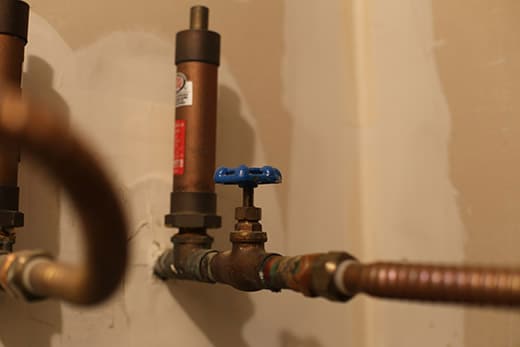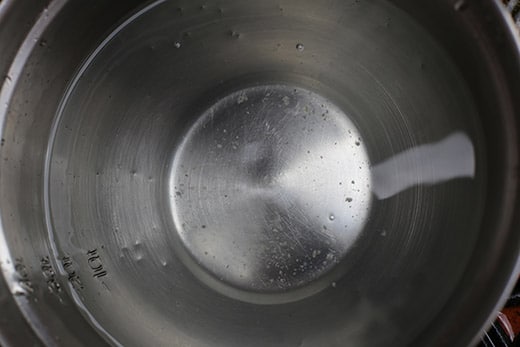When it comes to doing household chores, flushing your hot water heater is easy to overlook. I know I never thought about doing it until Jeremy included it in his truly handy home maintenance checklist.
But regularly flushing out your hot water heater is an important task. Getting rid of the gunk and mineral deposits that accumulate will help your hot water heater run more efficiently as well as prolong its life, saving you money in the long run.
After living in my home for several years, I figured my hot water heater was due for a flush and decided to tackle this chore. Fortunately, it turned out to be super easy. Excluding the time I was waiting for the water in the tank to cool, it took me all of about 20 minutes.
I documented the process as I did it, just in case you need to do likewise. Maybe this post will inspire you to finally knock this to-do off your list this weekend.
Here’s how:
How Often Should You Flush Your Hot Water Heater?
Depending on your model, aim to flush your hot water heater every one to three years. Really, the job is so easy, it wouldn’t be a bother to do it at least once a year.
How to Flush Your Hot Water Heater
Hot water heaters come in two varieties: gas and electric. I’ve got the gas variety, so these instructions will be geared towards flushing a gas hot water heater. The biggest difference between gas and electric is that with gas, you’ll be turning off the gas to your appliance; with an electric, you’ll be turning off the electricity.
1. Turn the Knob on Your Hot Water Heater’s Thermostat to “Off”

The thermostat on a gas hot water heater is usually found near the bottom of the tank. Other sources I ran across said you could get away with just setting your thermostat to “Pilot.” I decided to be extra safe and turned it off completely. If you turn your hot water heater off, and you have an older model, you’ll have to re-light your pilot light.
If you have an electric hot water heater, you’ll want to find your home’s breaker box and turn off the switch that gives power to your hot water heater.
2. Turn Off Gas to Hot Water Heater

If you have a gas hot water heater, find the gas pipe leading to your thermostat and pilot light and turn the valve to the off position. If you decide to just turn your thermostat to “pilot” you won’t need to do this step.
3. Turn Off the Cold Water Supply to Hot Water Heater
The cold water valve is usually near the top of your hot water heater. Turn it to off.
4. Turn on the Hot Water in a Sink or Tub

Leave them on during the entire flushing process. This will help prevent a vacuum from forming in the lines while you’re draining the hot water tank.
5. Connect Garden Hose to Drainage Spigot
Before you turn on the spigot, make sure the other end of the hose leads outside or at least into a bucket. If your hot water heater is in the basement, you may need to get a portable pump in order to pump water out of the basement and to the ground floor.
6. Turn on Spigot and Drain

Drain your tank until the water runs clear and no longer has sediment. If your tank has a lot of sediment, you may need to drain it completely. As you can see in this picture above, the water when I first started draining was a bit brown and there was a lot of sediment at the bottom of the bowl.
8. Flush

To flush your hot water tank, simply turn on the cold water spigot leading into your hot water tank. Let it run for a few minutes until the water exiting your hose runs clear.
This may take a bit. While the water might be running clear and isn’t brown, you may still have some sediment. Here’s a picture of the water coming from my tank when I first started flushing:
As you can see, I still had some sediment (can be seen at the bottom) coming out. Continue flushing until you have very little or no sediment in your water. Turn off the cold water spigot leading into your hot water tank.
Finishing Things Up
Once you’re satisfied with the clarity of your water, it’s time to put things back to the way they were.
- Turn off the drainage spigot and disconnect hose.
- Turn off the water on your sink or tub that you turned on at the beginning.
- Turn on the cold water spigot leading to your hot water heater.
- Turn on the hot water spigot of a sink or tub to get the air out of the system. Cold water should be coming out of the faucet at this point. Turn it off.
- If you shut off the gas to your hot water heater, turn it back on.
- If you turned the thermostat off on your hot water heater, re-light the pilot light (it’s easy — I may do a post on this in the future), and then turn it to on.
- If you have an electric hot water heater, flip the breaker switch on your electrical panel that gives power to your hot water heater.
- Wait about 20 minutes for the water to heat up. Turn on a hot water spigot somewhere in your house to ensure hot water is coming out.
Boom. You’ve flushed your hot water heater. Put it on your calendar to do it again in a year.






